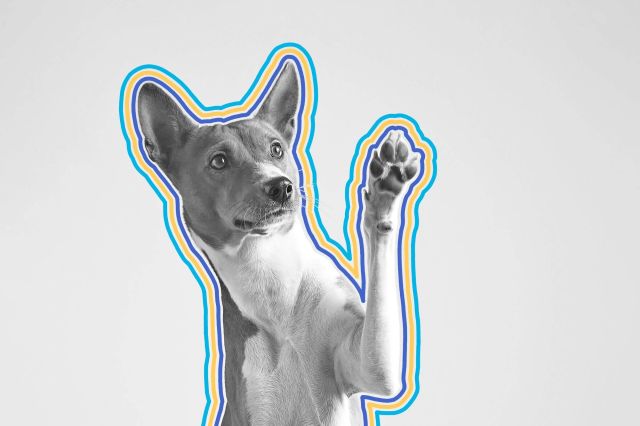
President Harding’s Dog Had His Own Seat at Cabinet Meetings
These days, presidential pets are almost as famous as their commanders in chief — but that wasn’t always the case. The first White House animal to really achieve celebrity status was President Warren G. Harding’s pup, an Airedale terrier named Laddie Boy, who lived in Washington, D.C., during the Harding administration from 1921 to 1923.
Laddie Boy was a fixture at the president’s side from the very beginning. In fact, on March 5, 1921, one day after taking office, Harding interrupted his first official Cabinet meeting to introduce the dog, who had just arrived from Ohio. After that, Laddie Boy became a regular at Cabinet meetings, and even had his own chair at the table. As part of Harding’s attempt to appeal to the average person and capitalize on his campaign slogan, which promised a “Return to Normalcy,” Laddie Boy also accompanied the president on the golf course, helped welcome foreign delegates, and once participated in the annual White House Easter Egg Roll. The pooch was beloved not only by Harding but by the press as well; newspapers would publish pretend interviews with fictitious quotes from Laddie Boy, much to the delight of the public. After Harding’s death, more than 19,000 newsboys donated pennies to be turned into a copper statue of Laddie Boy, which now belongs to Washington’s Smithsonian Institution.

The Dog Who Played Toto Earned $125 per Week
Few dogs are more famous than the cairn terrier who played Toto in 1939’s The Wizard of Oz. Terry, as she was known off-screen, was born in 1933 and rescued by Carl Spitz after being abandoned by her birth parents. Despite a tumultuous start to her life, she went on to have a prolific career in Hollywood that even many human actors would envy.
Spitz ran his own Hollywood Dog Training School, and although he initially took in Terry just as a pet, she quickly became his biggest star. His technique used silent hand signals, which gave him (and his dogs) an edge over other trainers who had to vocally call out their commands. With his help, Terry landed an uncredited role in 1934’s Ready for Love, and later that year starred alongside Shirley Temple in Bright Eyes. After appearing in several other films, Terry ascended to superstardom when she booked the role of Toto in The Wizard of Oz, earning $125 a week for portraying Dorothy’s trusted companion — more than some of her human castmates made.

The Beatles’ “A Day in the Life” Features a Whistle Only Dogs Can Hear
Back in 2013, the Beatles’ Paul McCartney revealed a little canine-related trick the band had included on their seminal 1967 album, Sgt. Pepper’s Lonely Hearts Club Band. At the end of the album’s final track, “A Day in the Life,” the Fab Four added a tone pitched at 15 kilohertz, making the sound audible to dogs but difficult to hear for most humans. The tone was reportedly added at the request of John Lennon, who asked producer George Martin to dub in the high-pitched frequency. “We’d talk for hours about these frequencies below the sub that you couldn’t really hear and the high frequencies that only dogs could hear,” McCartney explained. “If you ever play Sgt. Pepper, watch your dog.”
More Interesting Reads

Spiked Dog Collars Originated in Ancient Greece
Though they serve a more decorative purpose in modern times, spiked dog collars had an important use in ancient Greece, where they were originally conceived of as protection for pooches patrolling farms, as those dogs were susceptible to harm from random wolf attacks. Inspired by standard dog collars that had been developed in the ancient Egyptian city of Naucratis — with whom the Greeks frequently traded — Greek dog owners designed a couple of spiked options to defend against predators. One type of collar was made of metal, thus forming a kind of chain-link guard with spikes, whereas the other was made of leather with metal spikes poking through the material and secured by rivets. In both cases, the spikes were meant to protect the dog’s throat and potentially injure the attacking wolf.
Artistic depictions suggest the collars could also be symbols of status, perhaps ornamented with engravings. Dogs were important creatures within Greek society, and had a profound cultural impact as well. In his epic poem the Odyssey, for example, Homer wrote of Argos, the faithful dog who waits 20 years for the return of the hero Odysseus.

Some Domesticated Dog Breeds Date Back Millennia
There’s some debate around the oldest breed of domesticated dog, but if you go by the Guinness Book of World Records, that title belongs to the saluki, which is believed to have originated circa 329 BCE (though some experts posit it may date back even further to around 7000 BCE). Sometimes called the royal dog of Egypt, the saluki was heralded in ancient Egyptian society; the dogs were even honored with mummification after death, much like pharaohs at the time. In many Arab cultures throughout the Middle East, hunters used salukis — which boast incredible speed — to track and take down gazelle. The breed eventually made its way to England by the mid-1800s, and was finally recognized by the American Kennel Club in 1927.












